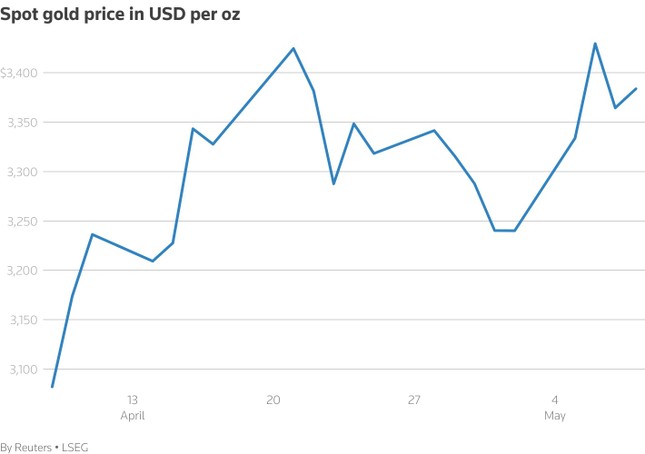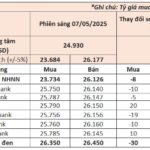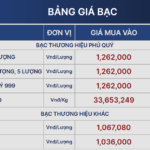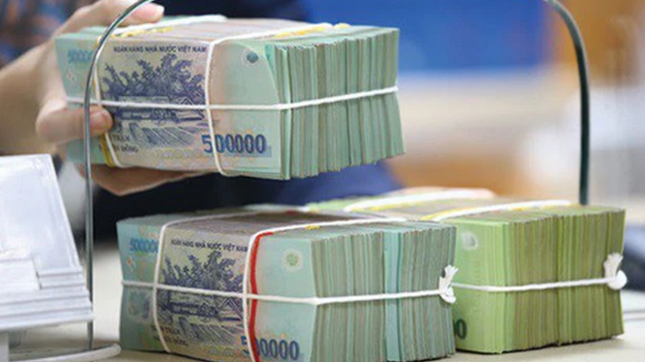Gold Prices Plummet Further
Gold prices plunged during the trading session on May 8th (May 9th in Vietnam) after US President Donald Trump announced a trade deal with the UK, raising hopes for similar agreements with other nations and diminishing gold’s safe-haven appeal.
Spot gold fell 1.7% to $3,307.84 an ounce. US gold futures dropped 2.5% to $3,306.
As per the deal announced by Trump and UK Prime Minister Keir Starmer, the 10% tariffs on goods imported from the UK into the US will remain. The UK agreed to reduce tariffs from 5.1% to 1.8% and enhance access for American goods.
Bob Haberkorn, senior market strategist at RJO Futures, commented: “If the US gets a deal with China, there’s a lot of resistance [for gold prices], down to at least $3,200.”
The market is closely watching the upcoming meeting in Switzerland on Saturday between US Treasury Secretary Scott Bessent, US Trade Representative Jamieson Greer, and top Chinese economic officials.

Gold prices continue to tumble following the US-UK trade deal.
Bullion, a hedge against geopolitical turmoil, has consistently hit record highs since Trump first imposed tariffs. The precious metal is now under pressure amid optimistic expectations for trade détente.
China’s central bank has approved a new quota for gold imports, allowing commercial banks to purchase foreign currency to pay for imports, which is expected to boost demand in the medium term.
However, Zain Vawda, an analyst at MarketPulse, a division of OANDA, opined: “In theory, this move boosts gold prices as increased demand from China becomes a trend. However, the market is dominated by tariff-related developments.”
Gold reserves in London vaults increased in April as precious metals were shipped back from New York to Europe. From December to March, market participants boosted gold deliveries to the US to hedge COMEX positions ahead of potential US import tariffs.
Silver fell to $32.48 an ounce. Platinum rose 0.8% to $981.60, and palladium climbed 0.3% to $974.81. Gold’s decline contrasted with a slight recovery in some other precious metals and industrial commodities, indicating a shift in investment flows as investors reassess risks.
Stocks Rebound After a String of Losses
Global stock markets rebounded as investors welcomed the US-UK trade deal as a positive signal for global trade negotiations.
In the US, major indices surged, led by the aviation and technology sectors. Aviation stocks soared after the US waived tariffs on aircraft parts produced by Rolls-Royce. The S&P 500 aviation carrier index jumped 5.4%, with Delta Air Lines leading the gainers, up 7.2%.
US Commerce Secretary Howard Lutnick confirmed the UK’s purchase of $10 billion worth of Boeing aircraft. This news pushed Boeing’s stock up 3.3%, making it the best performer in the Dow Jones index.
President Trump stated that he believed the negotiations with China, which will take place in Geneva this weekend, would be “more meaningful than initially thought,” emphasizing that he would not be surprised if a deal was reached.
Scott Welch, Chief Investment Officer at Certuity, commented: “Today’s announcement with the UK has had a positive reaction. Trump is a showman, so when he says that this weekend’s negotiations in Geneva will be significant, we have to take him at his word, but who knows.”
The Dow Jones Industrial Average rose 254.48 points, or 0.62%, to 41,368.45. The S&P 500 gained 32.66 points, or 0.58%, to 5,663.94.

The stock market shows signs of recovery.
The Nasdaq Composite added 189.98 points, or 1.07%, to 17,928.14. The small-cap Russell 2000 index climbed 1.9%, reaching its highest close since April 2, when the initial tariffs were announced.
The CBOE Volatility Index, often considered a measure of Wall Street’s fear gauge, posted its lowest close since early April, indicating a return to market confidence. The MSCI global index rose 0.10% to 844.86. Earlier, Europe’s STOXX 600 index closed 0.4% higher.
Yields on the 10-year US Treasury note rose 11.3 basis points to 4.388%. The 30-year yield climbed 8.1 basis points to 4.853%, while the 2-year yield increased 9.8 basis points to 3.891%.
John Velis, BNY’s macro strategist for the Americas, stated: “If tariff threats subside and the UK deal sets the tone for future agreements, I think the Fed won’t have to cut rates as much.”
The US dollar also strengthened. The dollar index rose 0.77% to 100.66. The British pound fell 0.42% to $1.3239 after the Bank of England cut interest rates. The euro dropped 0.67% to $1.1223.
The dollar gained 1.46% against the Japanese yen to 145.92 and climbed 1.01% versus the Swiss franc to 0.832. The Swedish crown weakened 0.77% to 9.744 after the central banks of Sweden and Norway hinted at possible rate cuts later this year.
Cryptocurrency Market Surges
The cryptocurrency market rallied strongly, with Bitcoin surpassing the $100,000 mark for the first time since early February, trading at $101,329.97, a 4.7% daily gain. Ether, the Ethereum blockchain’s currency, surged over 14% to $2,050.46.
Antoni Trenchev, co-founder of the digital asset trading platform Nexo, remarked: “Regaining the $100,000 level is a formidable ‘feat’ for bitcoin and a reminder that buying at $74,000 last month has paid off handsomely.”
He emphasized that the rapid recovery pace could propel Bitcoin towards the $109,000 level. Buying from long-term holders (at least 155 days) outpaced selling from short-term holders.
According to Joel Kruger, market strategist at financial technology firm LMAX Group, institutional investment money is flowing into bitcoin exchange-traded funds. Easing geopolitical tensions and China’s monetary stimulus measures have contributed to Bitcoin’s rebound after a prolonged decline since February.
Source: Reuters
“Gold Prices Surge as the Dollar Weakens: SPDR Gold Trust Sells Over 6 Tons of Gold This Week”
Global gold prices rose on Friday, May 9, trading above the $3,300/oz mark after a brief dip below this level earlier in the session.





















